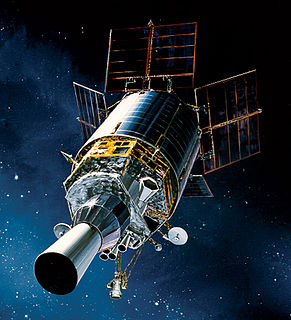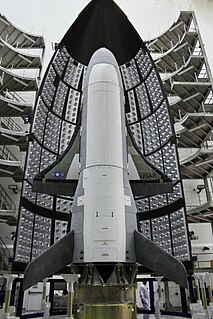 W
WAdvanced Extremely High Frequency (AEHF) is a series of communications satellites operated by the United States Space Force. They will be used to relay secure communications for the Armed Forces of the United States, the British Armed Forces, the Canadian Armed Forces, the Royal Netherlands Armed Forces and the Australian Defence Force. The system will consist of six satellites in geostationary orbits. The final satellite was launched on 26 March 2020. AEHF is backward compatible with, and will replace, the older Milstar system and will operate at 44 GHz Uplink and 20 GHz Downlink. The AEHF system is a joint service communications system that will provide survivable, global, secure, protected, and jam-resistant communications for high-priority military ground, sea and air assets.
 W
WThe AN/FPS-108 COBRA DANE is a PESA phased array radar installation operated by Raytheon for the United States Space Force at Eareckson Air Station on the island of Shemya, Aleutian Islands, Alaska. This radar system was built in 1976 and brought on-line in 1977 for the primary mission of gathering intelligence about Russia's ICBM program in support of verification of the SALT II arms limitation treaty. Its single face 29 m (95 ft) diameter phased array radar antenna 52.7373°N 174.0914°E faces the Kamchatka Peninsula and Russia's Kura Test Range. COBRA DANE operates in the 1215–1400 MHz band.
 W
WThe Defense Satellite Communications System (DSCS) is a United States Space Force satellite constellation that provides the United States with military communications to support globally distributed military users. Beginning in 2007, DSCS is being replaced by the Wideband Global SATCOM system. A total of 14 DSCS-III satellites were launched between the early 1980s and 2003. Two satellites were launched aboard the Space Shuttle Atlantis in 1985 during the STS-51-J flight. As of 23 November 2015, seven DSCS-III satellites were still operational. DSCS operations are currently run by the 4th Space Operations Squadron out of Schriever Air Force Base.
 W
WThe Defense Support Program (DSP) is a program of the United States Space Force that operated the reconnaissance satellites which form the principal component of the Satellite Early Warning System used by the United States.
 W
WEglin AFB Site C-6 is an United States Space Force radar station which houses the AN/FPS-85 phased array radar, associated computer processing system(s), and radar control equipment. Commencing operations in 1969, the AN/FPS-85 was the first large phased array radar. The entire radar/computer system is located at a receiver/transmitter building and is supported by the site's power plant, fire station, 2 water wells, and other infrastructure for the system. As part of the US Space Force's Space Surveillance Network its mission is to detect and track spacecraft and other manmade objects in Earth orbit for "the Joint Space Operations Center satellite catalogue". With a peak radiated power of 32 megawatts the Space Force claims it is the most powerful radar in the world, and can track a basketball-sized object up to 22,000 nautical miles from Earth.
 W
WThe Global Positioning System (GPS), originally Navstar GPS, is a satellite-based radionavigation system owned by the United States government and operated by the United States Space Force. It is one of the global navigation satellite systems (GNSS) that provides geolocation and time information to a GPS receiver anywhere on or near the Earth where there is an unobstructed line of sight to four or more GPS satellites. Obstacles such as mountains and buildings block the relatively weak GPS signals.
 W
WMilstar is a constellation of military communications satellites in geosynchronous orbit, which are operated by the United States Space Force, and provide secure and jam-resistant worldwide communications to meet the requirements of the Armed Forces of the United States. Six spacecraft were launched between 1994 and 2003, of which five are currently operational; the third launch failed, both damaging the satellite and leaving it in an unusable orbit.
 W
WThe Solid State Phased Array Radar System is a United States Space Force radar, computer, and communications system for missile warning and space surveillance "at five (5) geographically separated units worldwide including Beale AFB, CA, Cape Cod, AFS, MA, Clear AFS, AK, RAF Fylingdales, UK, and Thule AB, Greenland." SSPARS completed replacement of the RCA 474L Ballistic Missile Early Warning System when the last SSPAR was operational at Clear in 2001, the year SSPARS equipment included:Raytheon AN/FPS-123 PAVE PAWS Radar at Beale and Cape Cod Raytheon AN/FPS-120 Solid State Phased Array Radar at Thule ("2QFY87") with greater radar capabilities than the FPS-115 PAVE PAWS radars Raytheon AN/FPS-126 Solid State Phased Array Radar at Fylingdales with three faces for 360 degree coverage Raytheon AN/FPS-120 Solid State Phased Array Radar using an older antenna from the 1987 PAVE PAWS EWR in Texas
 W
WThe Space Fence is a second-generation space surveillance system operated by the United States Space Force in order to track artificial satellites and space debris in Earth orbit.
 W
WThe Space-Based Infrared System (SBIRS) is a United States Space Force system intended to meet the United States' infrared space surveillance needs through the first two to three decades of the 21st century. The SBIRS program is designed to provide key capabilities in the areas of missile warning, missile defense and battlespace characterization via satellites in geosynchronous earth orbit (GEO), sensors hosted on satellites in highly elliptical orbit (HEO), and ground-based data processing and control.
 W
WThe Wideband Global SATCOM system (WGS) is a high capacity United States Space Force satellite communications system planned for use in partnership by the United States Department of Defense (DoD), Canadian Department of National Defence (DND) and the Australian Department of Defence. The system is composed of the Space Segment satellites, the Terminal Segment users and the Control Segment operators.
 W
WThe Boeing X-37, also known as the Orbital Test Vehicle (OTV), is a reusable robotic spacecraft. It is boosted into space by a launch vehicle, then re-enters Earth's atmosphere and lands as a spaceplane. The X-37 is operated by the United States Space Force, and was previously operated by Air Force Space Command until 2019 for orbital spaceflight missions intended to demonstrate reusable space technologies. It is a 120-percent-scaled derivative of the earlier Boeing X-40. The X-37 began as a NASA project in 1999, before being transferred to the United States Department of Defense in 2004.